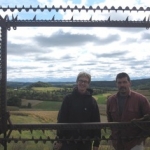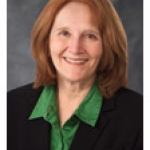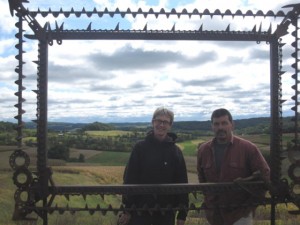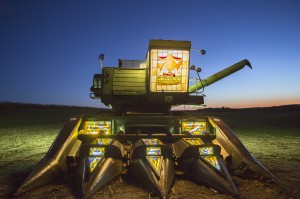February 2014 Blog Salon
February 2014 Blog Salon
The Power of Partnerships in Placemaking
February 2014 Blog Salon
Rural Communities as Cultural Hubs in Northern New Hampshire
February 2014 Blog Salon
Rural/Urban Exchange and the Rural Model
February 2014 Blog Salon
Young Artists in Small Towns: Contexts of Creativity
February 2014 Blog Salon
Rural Arts Resources Hunting Guide: Finding your inner soup stone
February 2014 Blog Salon
Arts and Mountains: Cultivating a Sense of Place – and Environmental Literacy – in Northern New Hampshire
February 2014 Blog Salon
It’s the Ecology, Stupid
February 2014 Blog Salon
Where Do Resources Come from in a Place without Resources?
February 2014 Blog Salon
Arts and Culture: Essential for Transition in the Kentucky Coalfields
February 2014 Blog Salon
Historic Buildings, Embodied Energy and Placemaking
February 2014 Blog Salon
6 Characteristics to Successful Arts and Rural Economic Development Efforts
February 2014 Blog Salon
Planning for the Arts in Rural Wyoming Communities
February 2014 Blog Salon
The Currency of Connection: the Arts and the Cooperative Extension Service as an alternative model to rural arts development
February 2014 Blog Salon
If You Live in a Place, You Will Find Art There
February 2014 Blog Salon
Rethinking Cultural Districts for Small Towns in Small States
February 2014 Blog Salon
Welcome to our Rural Arts Blog Salon!
February 2014 Blog Salon
Arts Resources for Rural America
February 2014 Blog Salon
It’s About Time; It’s About Place

Theresa Cameron
Thanks to all the writers and readers that participated in our Rural Arts Blog Salon!
Posted by Feb 24, 2014

Theresa Cameron
Wow! What a great week of blogs in our first Blog Salon on Rural Arts. Thanks to our bloggers and all our commentators, followers on Twitter, and Facebook fans.
As I read each of these blogs, I was inspired and encouraged about ways the arts are helping the economy, improving place, and creating change for rural America. I am from Wyoming and was an arts administrator on the frontier there for several years, so I especially loved Michael Lange’s blogs about how the arts are playing a leading role in revitalization efforts. This is especially challenging since Wyoming enjoys “the smallest population of any state, with 575,000 people and of the 99 incorporated municipalities, only about half have populations are over 1,000 people, and only a handful of those have a population over 10,000”.
Read More
Mr. Eric R. Rogers
The Power of Partnerships in Placemaking
Posted by Feb 24, 2014

Mr. Eric R. Rogers
Small places typically have small financial resources. That certainly describes the environment for Jay County (population 21,253), where Arts Place started in 1967. Small also often translates into limited audiences if an organization cannot reach beyond its traditional boundaries.
One way Arts Place has found to hurdle these obstacles has been to partner with our neighboring rural communities to create economies of scale. This approach also breaks some of the isolation natural to making the arts happen in places outside the urban mainstream.
Partnerships and collaborations have become second nature to Arts Place. While survival may have stimulated our early efforts, the benefits of such an approach have made reaching out to other communities and organizations our preferred way of making the arts happen.
Partnerships can be as simple as offering the same program in multiple communities. For example, Arts in the Parks, a series of summer workshops and community projects for children, requires significant overhead for planning, fund raising, and management during the program. But, by spreading the overhead amongst more than a dozen communities in five counties we created a more cost effective program.
Read More
Jamie Feinberg
Rural Communities as Cultural Hubs in Northern New Hampshire
Posted by Feb 24, 2014

Jamie Feinberg
Growing up in New Hampshire, my favorite days of the year -- a few major holidays excepted -- were Old Home Days. I loved the crafts, the animals, the special parades, performances and fireworks – it was part of what made our town so special. Cultural traditions still play a large role in defining local community identity in northern New Hampshire towns. While it can be tempting to focus exclusively on new art forms when we look for ways to use the arts as a driver of 21st century rural economic development, we’ve found that the key is often in discovering, acknowledging, appreciating, nurturing -- and then marketing and building upon -- what we already have.
The New Hampshire State Council on the Arts defines traditional arts as “artistic activities that are passed down from one generation to the next within families and communities and are regarded by the community as part of their heritage”. Whether we’re attending contra dances, purchasing locally woven ash baskets or fishing with a hand-tied fly, traditional arts feature prominently in both our daily life and in our celebrations.
Old Home Days were created in New Hampshire in the late nineteenth century to encourage sons and daughters who’d moved west after the Civil War to come home – for a visit or to stay – and to support their hometowns. This same need – to attract young people and to reconnect with one another -- exists in our rural communities today. Traditional arts have always been showcased at these celebrations, but it isn’t just the locals who appreciate them. These events have become popular with both tourists and new residents, people who are looking for authentic experiences and a glimpse of a unique community and culture. People from eight to eighty-eight can be seen both observing and participating in these community celebrations, which reflect past traditions while showcasing the best the town currently has to offer. (Oh, and did I mention they’re fun?!)
Read More
Matthew Glassman
Rural/Urban Exchange and the Rural Model
Posted by Feb 24, 2014

Matthew Glassman
For many of us working in the rural arts and culture movement, years have been spent incubating and developing our model. This April marks Double Edge Theatre’s 20th year of its Farm Center in Ashfield, MA---once a thriving dairy farm community that lost almost all of its nearly thirty farms over the course of the 80s. Double Edge previously was based in Boston and had established itself as an international company both in make-up and its touring/ research activities. The company first inhabited the Farm as a part time theatrical laboratory in April 1994 and eventually moved its full-time operations here by 1997 to create an international center for performance, collaboration, and training in the heart of rural Western Mass.
The Farm Center, a vision of Double Edge Founder and Artistic Director Stacy Klein, is this singular sort of place where creative research thrives and creativity and sustainability are deeply intertwined. The mutuality and duality between ‘W’ Work and ‘w’ work is fluid and holistic in the best and most earthbound sense. Performance, farming, administration, education, and deep individual and group research flow harmoniously on this fertile landscape in cyclical evolutions.
A slow, steady, and organic development has taken place in the past twenty years that includes renovations of barns, animal stalls, and buildings - but also a focused honing of our artistic practice and methodology and a continuous elevation of collaboration with our local community.
After recent touring to major cities in transition such as Baltimore and Hartford, as well as to more developed and gentrified places like Chicago and Washington D.C. (not to mention Moscow), it has become clear to our company through these interactions with these urban communities that now is the time for more highly developed inter-local exchange and cross pollination between these rural models and urban contexts as well as cross-pollination through rural to rural exchanges.
Read More
Michele Anderson
Young Artists in Small Towns: Contexts of Creativity
Posted by Feb 23, 2014

Michele Anderson
I live in a small town, I am an artist, and I am young.
In my work helping other artists with their careers, I spend a lot of time thinking about the types of resources younger artists need in rural communities. For the most part, this means just what you would expect: developing or identifying ways to help them find funding, sell their work, or learn new skills. But I also want to think more deeply than that: What kind of unique resources might actually motivate young artists to create art in the first place, be connected to their community and stick around to provide the strong, innovative leadership that small towns need right now?
In other words, what are the conditions of creativity and talent development in a small town, and how does this affect the $100 million-dollar question of rural America: Why do our young people stay or go?
Here at Springboard for the Arts' rural office, working with and encouraging younger artists has become a priority. Last Saturday, we led a day-long creative placemaking workshop on the role of art in historic preservation and economic development as part of our Imagine Fergus Falls initiative. Much to our surprise and delight, this workshop attracted a powerhouse of young artists from the region, most of whom had never met one another before.
Read More
Pat Boyd
Rural Arts Resources Hunting Guide: Finding your inner soup stone
Posted by Feb 23, 2014

Pat Boyd
Rural arts organizations like us are always hunting for resources. Sometimes it’s a treasure hunt. Sometimes it’s a scavenger hunt. Sounds like fun. That must be why we just can’t stop searching out ways to support ourselves! (Trumpets sound.)
Resourceful is near the top of the list of most admirable traits of rural Americans, followed unfortunately but necessarily by self-reliant and thrifty. We have to use as much imagination and skill to support arts opportunities as we do to create them.
You have license to go resource hunting within the territory defined by this circle of support and creation. Your carefully crafted mission and its resulting programs and projects come from there. They make your map, but there are no x’s to show where the hidden treasures lie.
Stray too far in your hunt for support and you risk losing your way in the real work of art. Your role as an arts organization in your rural community is complicated in ways that belie the apparent simplicity of size and setting. Best be clear in your purpose.
As hunters and gatherers for the arts, we have to stand in that clearing and think about that purpose. If you are having trouble finding support, it is good to figure out what is the matter. So start with what really matters:
What good does it do?
Who cares?
What does it take to do it?
What do you have now?
What are you looking for?
How much do you need and when?
If you know the answers without thinking, you are probably wrong. Take the time to explore the answers in full. If you go off half-cocked by making assumptions, you might hunt up some help and simultaneously create some problems you don’t need.
Getting and understanding the answers can lead to your best resources. You may be looking for support for general operations, a major program or a small project -- starting up, sustaining, or starting over, you make your case successfully if you know.
Read More
Jamie Feinberg
Arts and Mountains: Cultivating a Sense of Place – and Environmental Literacy - in Northern New Hampshire
Posted by Feb 22, 2014

Jamie Feinberg
It’s impossible to talk about what makes northern New Hampshire unique without talking about the environment. I’ve found that the stereotype of North Country residents -- hardy, resourceful and independent – is basically true, and I’m sure this is in no small part due to the landscape of our region, which captivates us – and, in some ways, holds us captive.
Northern New Hampshire is beautiful in all seasons, but our communities are also isolated; much of the region’s land mass is part of the 1,200 square mile White Mountain National Forest, with mountains, lakes, and rivers defining the area’s character, offering locals and visitors alike a wealth of recreation opportunities – and simultaneously separating even “neighboring” communities from one another.
Northern New Hampshire is more depressed economically than the rest of the Granite State. Since the economic center of New Hampshire is in its southern corridor, making a living up north is often a struggle, especially since the past few decades have seen almost all of the manufacturing and “big” businesses in the region close down or move elsewhere.
In the nineteenth century, our mountains drew some of the country’s greatest artists to the region, and the White Mountain artists and their work became associated with the identity, expansion and development of the region. Many of the grand (and not-so-grand) hotels housed “artists in residence,” whose images became important drivers and symbols of the new and thriving tourism industry.
Read More
Ms. Donna Neuwirth
It’s the Ecology, Stupid
Posted by Feb 22, 2014

Ms. Donna Neuwirth
Ecology and economy share the same root word, oikos referring to a household or family. Because it is at that level that these concepts can best be understood –a discrete unit that can sustain itself, financially, culturally and environmentally; large enough to have impact; diversified enough to be resilient, yet small enough to retain knowledge and control of its elements.
Economies in rural communities retains some of this compact nature. We operate at a level where our work can have measurable impact. We can communicate directly with elected officials, business leaders and seldom have to introduce ourselves more than twice.
Our original household economic goals were modest- we sought to derive a living by growing and marketing organic vegetables. Though our backgrounds were in the arts, we were used to performing duties not directly related to our vocation in order to pay the bills. But we quickly discovered that there were connections between the fields of culture and agriculture- not the least of which is the work of farming. But for us, without the necessary balance of art, it would prove unsustainable.
Because of this, the Wormfarm Institute has always found the relationship between a vibrant culture and economic activity to be a natural one. Over the past several years, as our projects have grown larger and more complex, involving several communities simultaneously we have come to value projects in part in terms of economic development. This isn’t a stretch or compromise but instead a natural result of working to increase diversity, vibrancy and resilience whether in our farm fields or our small downtown. This coincides with a nascent re-localization movement growing in response to the global economic upheavals of the last 8 years. It is easier now to make this oikos (human-scale) argument since most folks are aware how unwise it is to be dependent upon distant financial markets operated by self-interested entities, personal or corporate, untethered to any community.
Read More

Janet Brown
Where Do Resources Come from in a Place without Resources?
Posted by Feb 22, 2014

Janet Brown
People who work in the arts live in a perpetual state of aspiration and hope. We balance our budgets by projecting income that we “need” instead of income that we “expect.” Grantmakers in the Arts has spent four years focusing on the capitalization of arts organizations at GIA and other national conferences; through our web conferences, blogs, articles in the GIA Reader; and at our workshops for funders entitled Conversations on Capitalization and Community. Capitalization is defined simply as the resources an organization needs to accomplish its mission. The entire nonprofit sector operates in a business environment that is chaotic. It is the unpredictable nature of contributed income that makes the job of resource identification so difficult, requiring extreme cynicism and practical thinking by those trying to project budgets for the future.
This idea of projecting income in a chaotic marketplace is as important to the smallest of organizations as it is to the largest museum or opera company. Understanding how much money you need to exist and then understanding where that money will come from - this is the foundation of a good business model.
There is a false hope within the nonprofit world that all organizations, and even artists for that matter, can be saved by a good grant writer, that all we need to do is find a foundation and write a grant. The reality is that most organizations (and artists) are funded by only a small percentage of America’s foundations. About 10% of all foundation giving goes to the arts and one can probably predict without doing much research that the bulk of funding goes to institutions in urban centers.
Read More
Savannah Barrett
Arts Resources for Rural America
Posted by Feb 21, 2014

Savannah Barrett
From the coalfields of Appalachia to the lumber mills of the Cascades, rural people across the nation share a common desire to see the places where they live grow and prosper as livable, energetic communities. Many small communities in rural America have witnessed dwindling philanthropic investment in the twenty-first century. Although rural communities, labor, and expertise remain vital to health of our nation, reports of philanthropic investment in small communities average between 1-5%. As Rick Cohen referenced in the Non Profit Quarterly earlier this year, “Many rural nonprofits have probably given up on seeing philanthropy double its rural grant making in five years, as per the challenge issued by Senator Max Baucus (D-MT) to the Council on Foundations seven years ago, because of the historic underfunding of rural communities by foundations.”
Thankfully, this narrative is beginning to shift. While inequity in resource allocation to rural communities persists across the arts and culture sector; agencies, foundations, and support organizations are beginning to take note of the value of rural arts and humanities organizations, and are increasing their investment in rural communities. This blog post is aimed to inform rural arts and culture practitioners of the opportunities available for capital, human, and social investment in rural organizations.
The Year of the Rural Arts and the Rural Arts Resource Directory
2014 marks the inaugural Year of the Rural Arts: a biennial program of events, conversations, and online features celebrating the diverse, vital ways in which rural arts and humanities contribute to American life. This inaugural effort connects citizens, artists, scholars, designers, and entrepreneurs and meets with audiences on the grounds of universities, museums and galleries, cultural organizations, and across rural and urban communities. Coordinated by Art of the Rural and organized by a collective of individuals, organizations, and communities; we utilize a digital platform to elevate the rural arts field by facilitating rural-urban dialogue and cross-sector exchange.
Each time we partner with regional organizations to build digital networks on the Atlas of Rural Arts and Culture, we attempt to strengthen those networks on the ground by connecting rural organizations and individuals to one another, and to regional and national associations and opportunities. Through this process and the contributions of many advisors and stakeholders, we’ve created an online rural arts resource directory, complete with a variety of helpful toolkits, funding opportunities, networks and associations, conferences, webinars, professional development opportunities, websites, books, and articles related to rural arts and culture.
The range and diversity of resources included in this directory are exciting. We identified more than 50 funding and support opportunities for rural and cultural organizations from federal assistance programs, foundations, and corporate grant makers.
Read More




























